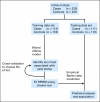DNA methylation array analysis identifies profiles of blood-derived DNA methylation associated with bladder cancer
- PMID: 21343564
- PMCID: PMC3083868
- DOI: 10.1200/JCO.2010.31.3577
DNA methylation array analysis identifies profiles of blood-derived DNA methylation associated with bladder cancer
Abstract
Purpose: Epigenetic alterations in tissues targeted for cancer play a causal role in carcinogenesis. Changes in DNA methylation in nontarget tissues, specifically peripheral blood, can also affect risk of malignant disease. We sought to identify specific profiles of DNA methylation in peripheral blood that are associated with bladder cancer risk and therefore serve as an epigenetic marker of disease susceptibility.
Methods: We performed genome-wide DNA methylation profiling on participants involved in a population-based incident case-control study of bladder cancer.
Results: In a training set of 112 cases and 118 controls, we identified a panel of 9 CpG loci whose profile of DNA methylation was significantly associated with bladder cancer in a masked, independent testing series of 111 cases and 119 controls (P < .0001). Membership in three of the most methylated classes was associated with a 5.2-fold increased risk of bladder cancer (95% CI, 2.8 to 9.7), and a model that included the methylation classification, participant age, sex, smoking status, and family history of bladder cancer was a significant predictor of bladder cancer (area under the curve, 0.76; 95% CI, 0.70 to 0.82). CpG loci associated with bladder cancer and aging had neighboring sequences enriched for transcription-factor binding sites related to immune modulation and forkhead family members.
Conclusion: These results indicate that profiles of epigenetic states in blood are associated with risk of bladder cancer and signal the potential utility of epigenetic profiles in peripheral blood as novel markers of susceptibility to this and other malignancies.
Conflict of interest statement
Authors' disclosures of potential conflicts of interest and author contributions are found at the end of this article.
Figures




References
-
- Jemal A, Siegel R, Ward E, et al. Cancer statistics, 2009. CA Cancer J Clin. 2009;59:225–249. - PubMed
-
- Parkin DM. The global burden of urinary bladder cancer. Scand J Urol Nephrol Suppl. 2008:12–20. - PubMed
-
- Hayat MJ, Howlader N, Reichman ME, et al. Cancer statistics, trends, and multiple primary cancer analyses from the Surveillance, Epidemiology, and End Results (SEER) Program. Oncologist. 2007;12:20–37. - PubMed
-
- Botteman MF, Pashos CL, Redaelli A, et al. The health economics of bladder cancer: A comprehensive review of the published literature. Pharmacoeconomics. 2003;21:1315–1330. - PubMed
-
- Kogevinas M, Trichopoulos D. Urinary bladder cancer. In: Adami H, Hunter DJ, Trichopoulos D, editors. Textbook of Cancer Epidemiology. London, England: Oxford University Press; 2002. pp. 446–466.
Publication types
MeSH terms
Substances
Grants and funding
LinkOut - more resources
Full Text Sources
Other Literature Sources
Medical
Molecular Biology Databases

